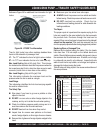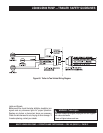
MAYCO LS400/LS500 PUMP — OPERATION AND PARTS MANUAL — REV. #6 (09/19/11) — PAGE 57
Step 1.
Locate the statement, “The weight of cargo should never
exceed XXX kg or XXX lbs.,” on your vehicle’s
Tire and Loading Information placard (Figure 56). This figure
equals the available amount of equipment load capacity.
Step 2.
Determine the weight of the equipment being loaded on the
tow vehicle. That weight may not safely exceed the avail-
able equipment load capacity. The trailer’s Tire Information
Placard is attached adjacent to or near the trailer’s VIN (Cer-
tification) label at the left front of the trailer.
Determining Load Limit of Tow Vehicle
Step 1.
Locate the statement, “The combined weight of
occupants and cargo should never exceed XXX lbs.,” on
your vehicle’s placard.
Step 2.
Determine the combined weight of the driver and passen-
gers who will be riding in your vehicle.
Step 3.
Subtract the combined weight of the driver and
passengers from XXX kilograms or XXX pounds.
Step 4.
The resulting figure equals the available amount of cargo and
luggage capacity. For example, if the “XXX” amount equals
1400 lbs. and there will be five 150 lb.
passengers in your vehicle, the amount of available cargo and
luggage capacity is 650 lbs. (1400-750 (5 x 150) = 650 lbs.).
Step 5.
Determine the combined weight of luggage and cargo being
loaded on the vehicle. That weight may not safely
exceed the available cargo and luggage capacity
calculated in Step 4.
If your vehicle will be towing a trailer, load from your trailer
will be transferred to your vehicle. Consult the tow vehicle’s
manual to determine how this weight transfer reduces the
available cargo and luggage capacity of your vehicle.
Studies of tire safety show that maintaining proper tire
pressure, observing tire and vehicle load limits (not carrying
more weight in your vehicle than your tires or vehicle can
safely handle), avoiding road hazards and inspecting tires
for cuts, slashes and other irregularities are the most
important things you can do to avoid tire failure, such as
tread separation or blowout and flat tires. These actions,
along with other care and maintenance activities, can also:
Improve vehicle handling
Help protect you and others from avoidable breakdowns
and accidents.
Improve fuel economy
Increase the tire life
Use the information contained in this section to make tire
safety a regular part of your vehicle maintenance routine.
Recognize that the time you spend is minimal compared
with the inconvenience and safety consequences of a flat
tire or other tire failure.
Tire Fundamentals
Federal law requires tire manufacturers to place standard-
ized information on the sidewall of all tires (Figure 57). This
information identifies and describes the fundamental char-
acteristics of the tire and also provides a tire identification
number for safety standard certification and in case of a
recall.
Figure 57. Standard Tire Sidewall Information
LS400/LS500 PUMP — TRAILER SAFETY GUIDELINES


















